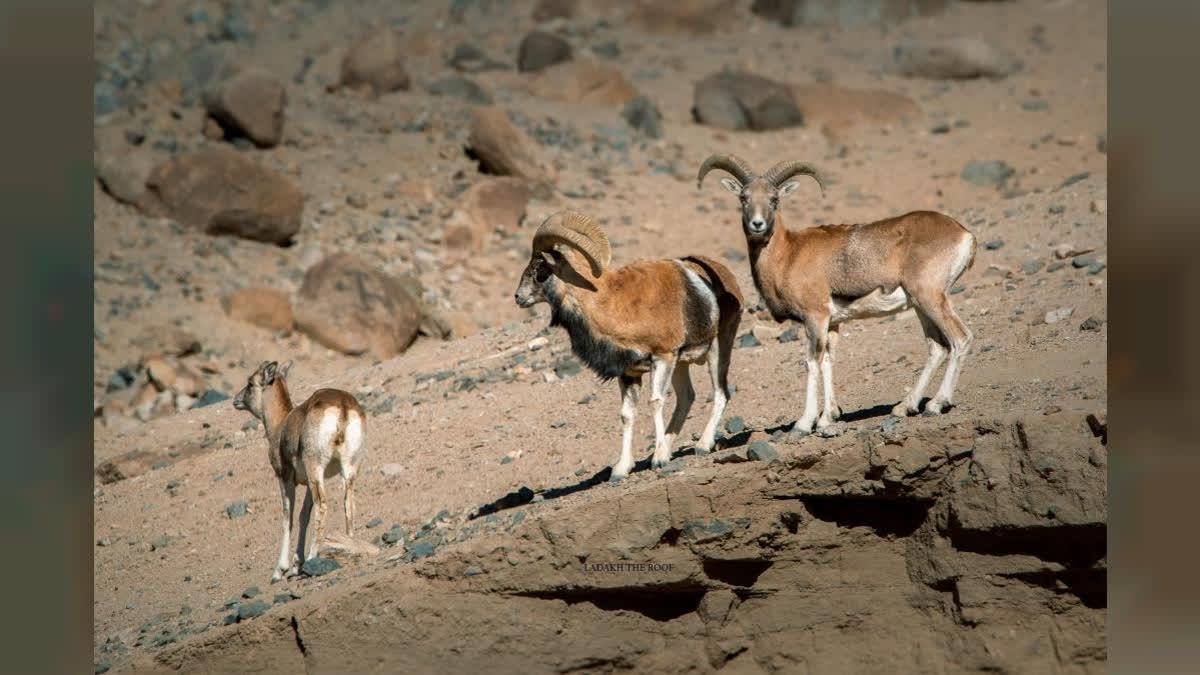
Leh: While observing and photographing wildlife in Leh-Ladakh, it is very easy to come across the Ladakh Urial, which is a species of wild sheep found in the cold desert of the region. It forms a sub species of the wild sheep genus Urial of the Central and South Asian region. This species of Urial is more or less restricted to the western part of the Union Territory of Ladakh primarily in the Sham and Nubra sub-regions. It is called Shapo by the Ladakhi people and it is situated at an altitude of 3000m to 4500m. Different attributes of the Ladakh Urial are large semicircles rounded horns and a coated skinless area at the middle of the chin and underbelly with males not very swift runners and the females having relatively small horns.
However, while one might be wondering whether it has a badly sighting, it difficult to come across it it is rather shocking to learn that it is listed as vulnerable in the IUCN red list of threatened species. The IUCN or International Union for Conservation of Nature as its abbreviated is one of the worldwide organizations in the sphere of the nature protection and effective utilization of resources. The intention of the IUCN red list is to raise awareness about the issue of conservation and influence the policy. On the national level the Ladakh Urial is listed in schedule I of the endangered species under Wildlife Protection Act 1972.
Considering that the Ladakh Urial has been featured in both these lists, hunting the population has been eliminated but its population still rife and the sparse sightings seen nowadays. The life of the major populations and habitats of the endangered species of snow leopards is illustrated by the words of Mohammad Arhaan, a young wildlife photographer from Leh, who said that people do not cherish them and consider them montane animals.
He has noted that people have invaded the mountains and constructed houses and concrete structures in this area that is an ideal habitat for the Ladakh Urial. Because they relocate to a higher altitude and as a result they have not adapted to such circumstance it may become a dangerous for them but they are forced to do it. Though hunting of the Ladakh Urial is banned, it is hunted at times because being on the lower altitude, it is comparatively easier to hunt this animal.”
He further explained that the local people have to realize that the Ladakh Urial resides only in Ladakh and not anywhere in the world and that is what makes it unique. This was also concurred with Mohd Imran who for the last decade has been filming wildlife and is a native wildlife filmmaker and the founder of Shan Productions.
He mentions that he has located Ladakh Urial in a count of 30 some of the time and in a count of 40 at other other times although he continues to point out that this species is currently endangered primarily due to feral dogs who hunt in on the young that cannot defend themselves since these chukars prefer to live on plateaus and they cannot run on the rocks when hunted by feral dogs. Most of them live close to water sources and thus easily vulnerable to Poaching.
These are as regarded by experienced professionals in the field and yet there seems to be a need to conduct a study to determine the decreasing population size of these organisms. A man from the Ladakh himself is an excellent naturalist but he concurs that studies on the Ladakh Urial have not been done adequately.
He argued that since its habitat is located at the lower altitude, the snow leopard is easy prey for it. There can also be the likelihood of a disease outbreak especially that the Ladakh Urial migrates closely with the livestock and in that case one may never know when a disease has spread among them.
As the chairman of the Wildlife Conservation and Birds Club of Ladakh (WCBCL) said, all the causes for the decrease of the only endemic mammal of this region have been initiated by human beings. He comments on them by saying, “first the humans killed the Ladakh Urial for food and horns; when the hunting was prohibited they brought feral dogs into the area and besides these two factors human beings deprived them of their living space as well.” “At the present rate of civilization however, in my opinion, the population of Ladakh Urial in the region of Ladakh is currently steady.”
Mr Smanla Tsering, a Wildlife Guard of the Wildlife Department was echoing the same sentiments he opined that awareness of the villagers is crucial. He informed that he makes the villagers aware about the food chain and makes them active to protect the Ladakh Urial.
He has revealed that, “when the villagers are informed, they get to know the significance and it is they who alert the department if ever the Ladakh Urial is wounded or if it is being pursued by stray dogs.” Moreover, he said that there are threats to the population of Ladakh Urial in this regard, as lesser snowfall has shrunk vegetation in the mountains where they majorly feed from. Also, with the expansion of human habitation, especially in areas with water bodies, they are left with no passage to cross and frequently have to cross highway roads.
Thus, in a bid to safeguard this rare species, both Gulzar Hussain and Mohd Imran affirmed that some contribution from the community is inevitable. These words are expressed by Gulzar Hussain who stated that Ladakh is a very vast area, and it is almost impossible for the officials to monitor everything. The premature should wake up and do what it takes to extent that it will prevent the dwindling of their habitat of the Ladakh Urial. Such actions at the ground level will go much further,” These are with due reference to the accomplishments realized in the space and are aimed at expounding more on the findings in the space.

 Share
Share






